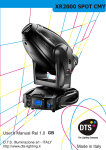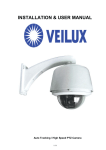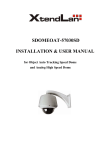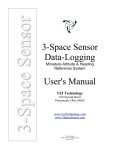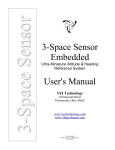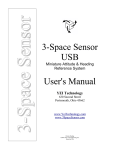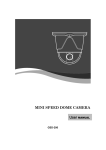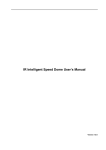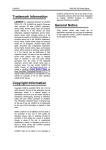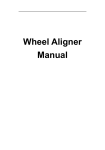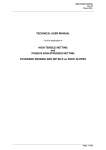Download INSTALLATION & USER MANUAL
Transcript
INSTALLATION & USER MANUAL Mini Auto Tracking / High Speed PTZ Camera Thank You for Choosing Our PTZ Camera! When you open the box: Check that the packing and the contents are not visibly damaged. Contact the retailer immediately if any parts are either missing or damaged. Make sure if the contents are all included as per the packing list. Do not attempt to use the device with missing or damaged parts. Send the product back in its original packing if it is damaged. The information contained in the document is subject to change without notice. i/i Table of Contents 1. 2. 3. 4. 5. Safety Notes --- Important!!! .............................................................................................................................1 About The Product ............................................................................................................................................2 2.1. Features.................................................................................................................................................. 2 2.2. Functions ................................................................................................................................................ 2 2.3. Technical Parameters ............................................................................................................................. 3 DIP Switch Setting .............................................................................................................................................5 Operation Guide ..............................................................................................................................................12 4.1. Operation At Power Up ..........................................................................................................................12 4.2. How To Use Our Control Keyboard .......................................................................................................12 4.2.1. Control Keypad Password And Access ......................................................................................12 4.2.2. Control Keypad Command Syntax .............................................................................................12 4.2.3. Control Keypad Command Types ..............................................................................................13 4.3. Select A Camera....................................................................................................................................13 4.4. Camera Motions.....................................................................................................................................13 4.4.1. Pan And Tilt Functions ...............................................................................................................13 4.4.2. Zoom Functions..........................................................................................................................14 4.4.3. Focus Functions .........................................................................................................................14 4.4.4. IRIS Opening Functions .............................................................................................................14 4.4.5. Preset Positions Programming and Recalling ............................................................................14 4.5. Function Program Menu.........................................................................................................................15 4.5.1. System Information Menu ..........................................................................................................16 4.5.2. Address setting...........................................................................................................................16 4.5.3. motion ........................................................................................................................................16 4.5.4. Patterns Submenu......................................................................................................................18 4.5.5. Camera ......................................................................................................................................18 4.5.6. Cruise Setting.............................................................................................................................20 4.5.6.1. Tracking Setting Submenu ..........................................................................................................20 4.6. Special Control Panel Commands .........................................................................................................22 Trouble Shooting .............................................................................................................................................23 ii / iii 1. SAFETY NOTES --- IMPORTANT!!! The following important notes must be followed carefully to run the PTZ camera and respective accessories in total safety. The camera and relative accessories are called video system in this section. Use the instructions correctly and fully Read all safety rules and instructions carefully before starting to run the video system. Follow the instructions in the instruction manual. Pay attention to all warnings on the camera and in the instruction manual. Keep the safety notes and instructions for future reference. Attachments & Accessories Do not use attachments other than those recommended in the instruction manual because this could cause risks to the products. Only use the recommended accessories for the camera for installation and operation. Protect the video system To protect the camera, avoid installing and using it in direct sunlight or any source of bright light. Bright light, like that from a spotlight, can cause dimming and blurs. A vertical line may appear on the screen. This does not indicate a problem. Keep it away from rain and dust. Do not touch the zoom lens with your fingers. If needed, use a soft cloth and methylated spirit to remove traces of dust. Apply a specific cap to protect the zoom lens when the camera is not in use. Install the camera away from video interference. The pictures could present interference if the leads are arranged near a TV set or other device. Either move the leads or re-install the device to solve the problem. Do not use any part of the video system near water, i.e. bathtubs, wash basins, sinks, tubs, on damp surfaces, near swimming pools, etc. Do not insert objects of any kind through the camera openings to avoid touch live parts: fire and electrocution risk. Do not pour any kind of liquid on the device. A switch for performing maintenance operations on the camera must be included. Connect the camera only to the electrical power supply shown on the ratings plate. Contact your retailer if in doubt. Lay the power wires keeping them from being trodden on or squeezed by objects placed on top of them. Pay particular attention to leads near plugs, screws and the product outlet. Disconnect the power lead and the wiring to protect the camera during electrical storms or when it is left unattended and not used for a long time. This will prevent damage to the video system in the event of lightening or electrical line overload. Do not overload the electrical power and the extensions to prevent the risk of fire or electrocution. Do not place the camera near or over radiators or sources of heat. Check that the area is suitably ventilated before installing the camera inside partially closed areas (such as recesses, bookshelves and shelves). Do not position the camera on unsteady trolleys, stands, brackets or tables. The camera could fall and severely injury adults and children in addition to seriously damaging the product. Maintenance & Repairs Always contact a qualified service technician to repair the camera (or any other part of the video system). Unauthorized opening or removing the lids may cause fire and electrocution risk and other dangers. Disconnect all electrical parts from the mains before cleaning. Uses spare parts specified by the manufacturer or spare parts with equivalent characteristics when replacements required. Unauthorized replacements can cause fires, electrical shocks and other dangers. After any servicing intervention or repair to the video system, ask the technician to run a safety check to ensure that everything is working safely. Damage requiring professional assistance Disconnect the video system from the power mains and call qualified service personnel in the following cases: If the power lead or plug is damaged. If liquid or foreign objects accidentally penetrate inside the device. If the device was exposed to rain or water. If the device was dropped, subjected to heavy shocks or if the camera packaging was damaged. If the device performance changes considerably. 1/1 2. ABOUT THE PRODUCT The tracking PTZ is based on our unique motion tracking technology with high position resolution, high speed, low price and selectable communication protocols. It is widely used in surveillance system as unattended CCTV device. 2.1. FEATURES Auto tracking of moving object (auto PTZ) based on our motion tracking technology; Max 10X optical, 10X digital zoom, day/night; 360º horizontal rotation at maximum speed of 360º /sec; Auto panning function with 256 preset positions; Built-in OSD Menu, to change dome parameter, save or call preset, and achieve auto scan, pattern etc; The feature of defining specific activity when the dome parks; Auto-flip to follow object and surveillance of any subject that is constant and continuous; The speed can be adjusted automatically according to zooming times; Auto focus lens and auto white balance, BLC function; Multi protocol compatible (Pelco-P, Pelco-D etc); Alarm input, Alarm output, Alarm action. 2.2. FUNCTIONS Object Tracking In auto tracking mode, the camera can track a moving object in the target area with auto pan, tilt and zoom which realizes smart unattended surveillance. Tracking Cruise The tracking function can be activated during cruise. At a preset of the cruise list, the camera can track moving objects automatically. After the moving object moves out of view, the camera will go back to cruising mode again. Soft Address The camera address can be programmed with built-in OSD menu, and the user does not need to dismount the camera from field or do any screw work. Day/Night Function The IR cut filter of camera module inside the camera can be removed by sending special command, so that the camera can change from color to mono. The picture is clear even if the illumination is as low as 0.01Lux. Proportional Pan Proportional pan automatically reduces or increases the pan and tilt speeds in proportion to the zooming times. At telephoto zoom settings, the pan and tilt speeds will be slower for a given amount of joystick deflection then at wide zoom settings. This keeps the image from moving too fast on the monitor when there is a large amount of zoom. Auto Flip When the camera tilts downward and goes just beyond the vertical angle, the camera rotates 180º. When the camera rotates (flips), the camera starts moving upward as you continue to hold joystick in the down position. Once you let go of the joystick after the dome rotates, joystick control returns to normal operation. The auto-flip feature is useful for following a person who passes directly beneath the camera. Save/Call Preset Preset function is that dome saves current horizontal angle and title angle of pan/tilt, zoom and position parameters into memory. When necessary dome calls these parameters and adjusts Pan/Tilt and camera to that position. User can save and call presets easily and promptly by using keyboard controller or other controllers. The camera supports up to 256 presets. Lens Control 1) Zoom control User can adjust zoom wide or tele by controller to get desired image. 2) Focus control System defaults Auto Focus mode, that is, the lens and camera will automatically adjust the focus to get the best image. Focus can also be controlled manually from the controller if required. Press Focus Near or Focus Far key to manually focus. Focus can be manual via keyboard or matrix, please refer to control keyboard or matrix operation manual for detailed operation. When adjusting position is set with focus status, it goes back to auto focus. 2/2 The camera will NOT auto focus in the following status. Target is not in the center of image. Targets are in near and far at the same time. Target is of strong light object. Such as spotlight etc. Target is behind the glass with water drop or dust. Target moves too fast. Large area target such as wall. Target is too dark or vague. 3) IRIS control System defaults Auto IRIS. Camera can adjust immediately according to the alteration of back ground illumination so that a lightness steady image can be achieved. You may adjust IRIS by controller to get required image brightness, and get back Auto IRIS by controlling the joystick. Auto White Balance Camera can automatically adjust white balance (WB) according to the alteration of background lightness to give a true color image. Back Light Compensation (BLC) If a bright backlight presents, the subjects in the picture may appear dark or as a silhouette. Backlight compensation enhances objects in the center of the picture. The camera uses the center of the picture to adjust the IRIS. If there is a bright light source outside this area, it will wash out to white. The camera will adjust the IRIS so that the object in the sensitive area is properly exposed. Auto Cruise The preset position is programmed to be recalled in sequence. This feature is called auto cruise. Up to 20 presets can be saved in each cruise tour. Patterns A pattern is a saved, repeating, series of pan, tilt, zoom and preset functions that can be recalled with a command from a controller or automatically by a programmed function (alarm action or park action or power-up action). Auto, Random and Frame Scan Auto Scan: Make the camera scan 360º ranging from the current position. Random Scan: Make the camera random scan 360º ranging from the current position. Frame Scan: This feature freezes the scene on the monitor when going to a preset. This allows for smooth transition from one preset scene to another. Zones Setting A zone is a pan area, defined by a left and right limit, on the 360º pan plane. The camera has eight zones, each with a 6-character label. 2.3. TECHNICAL PARAMETERS Function Object auto tracking Signal Format PAL/NTSC Image Sensor ¼ inch color CCD H. Resolution 570 TVL (Black), 500 TVL (Color) Zoom 10X optical; 10X digital Day/Night Yes Sensitivity 0.7Lux (Color) / 0.02Lux (Black) S/N Ratio ≥50DB (AGC off) AGC Auto/Manual BLC Auto/Manual WB Auto/Manual P/T Range PAN:360º continuous; TILT: 90º auto flip P/T Speed PAN:0.05º~240º/sec;TILT:0.03º~160º/sec Presets 256 3/3 Pattern Scan 4 routes of pattern scan Auto Cruise Auto switch from 1 – 20 preset positions sequentially Comm. Port RS485 Protocols PELCO-D, PELCO-P OSD Menu English Power DC12V Working Temperature 0ºC ~ 40ºC Table 1: Technical Data The specifications are subject to change without notice. 4/4 3. INSTALLATION This section contains detailed instructions for installing the camera. These instructions assume that the installer has a good knowledge of installation techniques and is capable of adopting safe installation methods. 3.1. DIP SWITCH SETTING Before installing the camera drive, check the DIP switches on the main PCB board; configure the receiver address, communication protocol, and baud rate setting. The default settings are:receiver address is “1”,communication protocol is “PELCO-D”, baud rate is “9600”.错误!未找到引用源。 shows the default settings for the DIP switches. Pic.1 Default settings of DIP switches Please refer to the following tables to set baud rate, and communication protocol type and camera address. POS COMM PTOL POS BAUD RATE (BPS) 1 2 DESCRIPTION OFF OFF PELCO-P ON OFF …… PELCO-D Reserved for future use DESCRIPTION 3 4 2400 ON OFF 4800 OFF ON 9600 ON ON Reserved for future use Table 2: SWITCH1 SETTING 5/5 … Address 1 2 3 4 5 6 7 8 0 OFF OFF OFF OFF OFF OFF OFF OFF 1 ON OFF OFF OFF OFF OFF OFF OFF 2 OFF ON OFF OFF OFF OFF OFF OFF 3 ON ON OFF OFF OFF OFF OFF OFF 4 OFF OFF ON OFF OFF OFF OFF OFF 5 ON OFF ON OFF OFF OFF OFF OFF 6 OFF ON ON OFF OFF OFF OFF OFF 7 ON ON ON OFF OFF OFF OFF OFF 8 OFF OFF OFF ON OFF OFF OFF OFF 9 ON OFF OFF ON OFF OFF OFF OFF 10 OFF ON OFF ON OFF OFF OFF OFF 11 ON ON OFF ON OFF OFF OFF OFF 12 OFF OFF ON ON OFF OFF OFF OFF 13 ON OFF ON ON OFF OFF OFF OFF 14 OFF ON ON ON OFF OFF OFF OFF 15 ON ON ON ON OFF OFF OFF OFF 16 OFF OFF OFF OFF ON OFF OFF OFF 17 ON OFF OFF OFF ON OFF OFF OFF 18 OFF ON OFF OFF ON OFF OFF OFF 19 ON ON OFF OFF ON OFF OFF OFF 20 OFF OFF ON OFF ON OFF OFF OFF 21 ON OFF ON OFF ON OFF OFF OFF 22 OFF ON ON OFF ON OFF OFF OFF 23 ON ON ON OFF ON OFF OFF OFF 24 OFF OFF OFF ON ON OFF OFF OFF 25 ON OFF OFF ON ON OFF OFF OFF 26 OFF ON OFF ON ON OFF OFF OFF 27 ON ON OFF ON ON OFF OFF OFF 28 OFF OFF ON ON ON OFF OFF OFF 29 ON OFF ON ON ON OFF OFF OFF 30 OFF ON ON ON ON OFF OFF OFF 31 ON ON ON ON ON OFF OFF OFF 32 OFF OFF OFF OFF OFF ON OFF OFF 33 ON OFF OFF OFF OFF ON OFF OFF 34 OFF ON OFF OFF OFF ON OFF OFF 35 ON ON OFF OFF OFF ON OFF OFF 36 OFF OFF ON OFF OFF ON OFF OFF 37 ON OFF ON OFF OFF ON OFF OFF 38 OFF ON ON OFF OFF ON OFF OFF 39 ON ON ON OFF OFF ON OFF OFF 40 OFF OFF OFF ON OFF ON OFF OFF 41 ON OFF OFF ON OFF ON OFF OFF 42 OFF ON OFF ON OFF ON OFF OFF 43 ON ON OFF ON OFF ON OFF OFF 44 OFF OFF ON ON OFF ON OFF OFF 45 ON OFF ON ON OFF ON OFF OFF 46 OFF ON ON ON OFF ON OFF OFF 47 ON ON ON ON OFF ON OFF OFF 48 OFF OFF OFF OFF ON ON OFF OFF 49 ON OFF OFF OFF ON ON OFF OFF 6/6 50 51 OFF ON ON ON OFF OFF OFF OFF ON ON ON ON OFF OFF OFF OFF 52 OFF OFF ON OFF ON ON OFF OFF 53 ON OFF ON OFF ON ON OFF OFF 54 OFF ON ON OFF ON ON OFF OFF 55 ON ON ON OFF ON ON OFF OFF 56 OFF OFF OFF ON ON ON OFF OFF 57 ON OFF OFF ON ON ON OFF OFF 58 OFF ON OFF ON ON ON OFF OFF 59 ON ON OFF ON ON ON OFF OFF 60 OFF OFF ON ON ON ON OFF OFF 61 ON OFF ON ON ON ON OFF OFF 62 OFF ON ON ON ON ON OFF OFF 63 ON ON ON ON ON ON OFF OFF 64 OFF OFF OFF OFF OFF OFF ON OFF 65 ON OFF OFF OFF OFF OFF ON OFF 66 OFF ON OFF OFF OFF OFF ON OFF 67 ON ON OFF OFF OFF OFF ON OFF 68 OFF OFF ON OFF OFF OFF ON OFF 69 ON OFF ON OFF OFF OFF ON OFF 70 OFF ON ON OFF OFF OFF ON OFF 71 ON ON ON OFF OFF OFF ON OFF 72 OFF OFF OFF ON OFF OFF ON OFF 73 ON OFF OFF ON OFF OFF ON OFF 74 OFF ON OFF ON OFF OFF ON OFF 75 ON ON OFF ON OFF OFF ON OFF 76 OFF OFF ON ON OFF OFF ON OFF 77 ON OFF ON ON OFF OFF ON OFF 78 OFF ON ON ON OFF OFF ON OFF 79 ON ON ON ON OFF OFF ON OFF 80 OFF OFF OFF OFF ON OFF ON OFF 81 ON OFF OFF OFF ON OFF ON OFF 82 OFF ON OFF OFF ON OFF ON OFF 83 ON ON OFF OFF ON OFF ON OFF 84 OFF OFF ON OFF ON OFF ON OFF 85 ON OFF ON OFF ON OFF ON OFF 86 OFF ON ON OFF ON OFF ON OFF 87 ON ON ON OFF ON OFF ON OFF 88 OFF OFF OFF ON ON OFF ON OFF 89 ON OFF OFF ON ON OFF ON OFF 90 OFF ON OFF ON ON OFF ON OFF 91 ON ON OFF ON ON OFF ON OFF 92 OFF OFF ON ON ON OFF ON OFF 93 ON OFF ON ON ON OFF ON OFF 94 OFF ON ON ON ON OFF ON OFF 95 ON ON ON ON ON OFF ON OFF 96 OFF OFF OFF OFF OFF ON ON OFF 97 ON OFF OFF OFF OFF ON ON OFF 98 OFF ON OFF OFF OFF ON ON OFF 99 ON ON OFF OFF OFF ON ON OFF 100 OFF OFF ON OFF OFF ON ON OFF 7/7 101 102 ON OFF OFF ON ON ON OFF OFF OFF OFF ON ON ON ON OFF OFF 103 ON ON ON OFF OFF ON ON OFF 104 OFF OFF OFF ON OFF ON ON OFF 105 ON OFF OFF ON OFF ON ON OFF 106 OFF ON OFF ON OFF ON ON OFF 107 ON ON OFF ON OFF ON ON OFF 108 OFF OFF ON ON OFF ON ON OFF 109 ON OFF ON ON OFF ON ON OFF 110 OFF ON ON ON OFF ON ON OFF 111 ON ON ON ON OFF ON ON OFF 112 OFF OFF OFF OFF ON ON ON OFF 113 ON OFF OFF OFF ON ON ON OFF 114 OFF ON OFF OFF ON ON ON OFF 115 ON ON OFF OFF ON ON ON OFF 116 OFF OFF ON OFF ON ON ON OFF 117 ON OFF ON OFF ON ON ON OFF 118 OFF ON ON OFF ON ON ON OFF 119 ON ON ON OFF ON ON ON OFF 120 OFF OFF OFF ON ON ON ON OFF 121 ON OFF OFF ON ON ON ON OFF 122 OFF ON OFF ON ON ON ON OFF 123 ON ON OFF ON ON ON ON OFF 124 OFF OFF ON ON ON ON ON OFF 125 ON OFF ON ON ON ON ON OFF 126 OFF ON ON ON ON ON ON OFF 127 ON ON ON ON ON ON ON OFF 128 OFF OFF OFF OFF OFF OFF OFF ON 129 ON OFF OFF OFF OFF OFF OFF ON 130 OFF ON OFF OFF OFF OFF OFF ON 131 ON ON OFF OFF OFF OFF OFF ON 132 OFF OFF ON OFF OFF OFF OFF ON 133 ON OFF ON OFF OFF OFF OFF ON 134 OFF ON ON OFF OFF OFF OFF ON 135 ON ON ON OFF OFF OFF OFF ON 136 OFF OFF OFF ON OFF OFF OFF ON 137 ON OFF OFF ON OFF OFF OFF ON 138 OFF ON OFF ON OFF OFF OFF ON 139 ON ON OFF ON OFF OFF OFF ON 140 OFF OFF ON ON OFF OFF OFF ON 141 ON OFF ON ON OFF OFF OFF ON 142 OFF ON ON ON OFF OFF OFF ON 143 ON ON ON ON OFF OFF OFF ON 144 OFF OFF OFF OFF ON OFF OFF ON 145 ON OFF OFF OFF ON OFF OFF ON 146 OFF ON OFF OFF ON OFF OFF ON 147 ON ON OFF OFF ON OFF OFF ON 148 OFF OFF ON OFF ON OFF OFF ON 149 ON OFF ON OFF ON OFF OFF ON 150 OFF ON ON OFF ON OFF OFF ON 151 ON ON ON OFF ON OFF OFF ON 8/8 152 153 OFF ON OFF OFF OFF OFF ON ON ON ON OFF OFF OFF OFF ON ON 154 OFF ON OFF ON ON OFF OFF ON 155 ON ON OFF ON ON OFF OFF ON 156 OFF OFF ON ON ON OFF OFF ON 157 ON OFF ON ON ON OFF OFF ON 158 OFF ON ON ON ON OFF OFF ON 159 ON ON ON ON ON OFF OFF ON 160 OFF OFF OFF OFF OFF ON OFF ON 161 ON OFF OFF OFF OFF ON OFF ON 162 OFF ON OFF OFF OFF ON OFF ON 163 ON ON OFF OFF OFF ON OFF ON 164 OFF OFF ON OFF OFF ON OFF ON 165 ON OFF ON OFF OFF ON OFF ON 166 OFF ON ON OFF OFF ON OFF ON 167 ON ON ON OFF OFF ON OFF ON 168 OFF OFF OFF ON OFF ON OFF ON 169 ON OFF OFF ON OFF ON OFF ON 170 OFF ON OFF ON OFF ON OFF ON 171 ON ON OFF ON OFF ON OFF ON 172 OFF OFF ON ON OFF ON OFF ON 173 ON OFF ON ON OFF ON OFF ON 174 OFF ON ON ON OFF ON OFF ON 175 ON ON ON ON OFF ON OFF ON 176 OFF OFF OFF OFF ON ON OFF ON 177 ON OFF OFF OFF ON ON OFF ON 178 OFF ON OFF OFF ON ON OFF ON 179 ON ON OFF OFF ON ON OFF ON 180 OFF OFF ON OFF ON ON OFF ON 181 ON OFF ON OFF ON ON OFF ON 182 OFF ON ON OFF ON ON OFF ON 183 ON ON ON OFF ON ON OFF ON 184 OFF OFF OFF ON ON ON OFF ON 185 ON OFF OFF ON ON ON OFF ON 186 OFF ON OFF ON ON ON OFF ON 187 ON ON OFF ON ON ON OFF ON 188 OFF OFF ON ON ON ON OFF ON 189 ON OFF ON ON ON ON OFF ON 190 OFF ON ON ON ON ON OFF ON 191 ON ON ON ON ON ON OFF ON 192 OFF OFF OFF OFF OFF OFF ON ON 193 ON OFF OFF OFF OFF OFF ON ON 194 OFF ON OFF OFF OFF OFF ON ON 195 ON ON OFF OFF OFF OFF ON ON 196 OFF OFF ON OFF OFF OFF ON ON 197 ON OFF ON OFF OFF OFF ON ON 198 OFF ON ON OFF OFF OFF ON ON 199 ON ON ON OFF OFF OFF ON ON 200 OFF OFF OFF ON OFF OFF ON ON 201 ON OFF OFF ON OFF OFF ON ON 202 OFF ON OFF ON OFF OFF ON ON 9/9 203 204 ON OFF ON OFF OFF ON ON ON OFF OFF OFF OFF ON ON ON ON 205 ON OFF ON ON OFF OFF ON ON 206 OFF ON ON ON OFF OFF ON ON 207 ON ON ON ON OFF OFF ON ON 208 OFF OFF OFF OFF ON OFF ON ON 209 ON OFF OFF OFF ON OFF ON ON 210 OFF ON OFF OFF ON OFF ON ON 211 ON ON OFF OFF ON OFF ON ON 212 OFF OFF ON OFF ON OFF ON ON 213 ON OFF ON OFF ON OFF ON ON 214 OFF ON ON OFF ON OFF ON ON 215 ON ON ON OFF ON OFF ON ON 216 OFF OFF OFF ON ON OFF ON ON 217 ON OFF OFF ON ON OFF ON ON 218 OFF ON OFF ON ON OFF ON ON 219 ON ON OFF ON ON OFF ON ON 220 OFF OFF ON ON ON OFF ON ON 221 ON OFF ON ON ON OFF ON ON 222 OFF ON ON ON ON OFF ON ON 223 ON ON ON ON ON OFF ON ON 224 OFF OFF OFF OFF OFF ON ON ON 225 ON OFF OFF OFF OFF ON ON ON 226 OFF ON OFF OFF OFF ON ON ON 227 ON ON OFF OFF OFF ON ON ON 228 OFF OFF ON OFF OFF ON ON ON 229 ON OFF ON OFF OFF ON ON ON 230 OFF ON ON OFF OFF ON ON ON 231 ON ON ON OFF OFF ON ON ON 232 OFF OFF OFF ON OFF ON ON ON 233 ON OFF OFF ON OFF ON ON ON 234 OFF ON OFF ON OFF ON ON ON 235 ON ON OFF ON OFF ON ON ON 236 OFF OFF ON ON OFF ON ON ON 237 ON OFF ON ON OFF ON ON ON 238 OFF ON ON ON OFF ON ON ON 239 ON ON ON ON OFF ON ON ON 240 OFF OFF OFF OFF ON ON ON ON 241 ON OFF OFF OFF ON ON ON ON 242 OFF ON OFF OFF ON ON ON ON 243 ON ON OFF OFF ON ON ON ON 244 OFF OFF ON OFF ON ON ON ON 245 ON OFF ON OFF ON ON ON ON 246 OFF ON ON OFF ON ON ON ON 247 ON ON ON OFF ON ON ON ON 248 OFF OFF OFF ON ON ON ON ON 249 ON OFF OFF ON ON ON ON ON 250 OFF ON OFF ON ON ON ON ON 251 ON ON OFF ON ON ON ON ON 252 OFF OFF ON ON ON ON ON ON 253 ON OFF ON ON ON ON ON ON 10 / 10 254 255 OFF ON ON ON ON ON ON ON ON ON ON ON ON ON ON ON Table 3: SWITCH2 SETTING Always use the “PELCO P” or “PELCO D” protocols. It is advisable to select PELCO-D protocol at 9600 bps baud rate to ensure the correct operation of the camera with the compatible products in the catalogue. Do not use address “0” with the “PELCO P” or “PELCO D” protocols. 11 / 11 4. OPERATION GUIDE 4.1. OPERATION AT POWER UP The camera employs the default settings the first time it is switched on. Changes to the settings will be permanently stored and will be made available the next time the camera is switched on. You can return to the default settings by means of the appropriate menu option at any time. The camera will work as follows when it is switched on. The camera will run a calibration procedure and a message showing the following information will appear on the video output OSD (On Screen Display): protocol, communication parameters, and camera address and software version. Check that the data are suitable for operation. Otherwise, refer to the section in this document that shows how to install the camera correctly PTOL: PELCO-D COM: 2400, N, 8, 1 ADDR: 0 At the end of the calibration step, the camera will switch to stand-by as programmed (POWER UP ACTION in MOTION > POWER UP). The camera will continue working this way until any command is received from the controller. The camera during this phase can be pointed to a fixed point or pan across the field. Refer to the details described in the POWER UP ACTION menu section for more details. 4.2. HOW TO USE OUR CONTROL KEYBOARD The camera is ready to receive commands from our control keyboard (see figure below) after connecting. 4.2.1. CONTROL KEYPAD PASSWORD AND ACCESS The system will wait for the password to be entered after being switched on. The control panel requires a 6-digit password. The entered digits will be replaced by a “*” symbol on the screen for privacy. Access to the menu is gained after entering all the digits correctly. Refer to the corresponding manual for using the control panel. The default user password is “000000”. It is advisable to change the default password to prevent intrusions. Do not lose or forget the programmed password. Take note of the new password and keep it in a safe place. 4.2.2. CONTROL KEYPAD COMMAND SYNTAX Controls can use the joystick, single keys or key combinations. The key command syntax is shown below. Key command syntax The syntax used in this manual for controls using keys consists of various elements (words and three digit numbers). Each command is always in braces and each element is separated by commas. Each word or decimal digit used in the syntax is identified by a corresponding key on our control panel. Words can be enclosed in round brackets, square brackets or no brackets. Three digit decimals are never enclosed in brackets. The following words only can be used: PRESET, CALL, ESC, OPEN, CLOSE, NEAR, FAR, ZOOM OUT, ZOOM IN, CAM, MON, SCAN, ENTER. The decimal digits are: 0, 1, 2, 3, 4, 5, 6, 7, 8, and 9. Some application examples of controls are shown in detail below. 12 / 12 Using the joystick A command can also be given simply by moving the joystick because this generates actions on the camera or OSD (On Screen Display) menu. Using a single key Pressing a single key can cause camera action. For example, the following command will zoom out of the frame. Underling indicates the key is in use. ZOOM OUT Key combinations Pressing a key combination in rapid sequence extents the command set. For example, the following command (select camera address 1) is performed by pressing the following keys: CAM + 1 + ENTER 4.2.3. CONTROL KEYPAD COMMAND TYPES There are four command types: Select camera, Move camera (tilt and pan, zoom, adjust focus and IRIS opening, go to preset positions), Adjust camera operation mode using menus, Various quick controls operable from the control panel. The method for accessing these controls will be shown in detail in the following paragraphs. 4.3. SELECT A CAMERA The camera to be controlled must be selected first. For example, the following command selects camera 1: CAM + 1 + ENTER After this operation, the message CAM 1 will appear on the control panel display. 4.4. CAMERA MOTIONS After selecting a camera, it can be moved either directly using the control panel as described below: Panning (horizontal) and tilting (vertical). Zooming, focusing and IRIS opening. Preset positions programming and recalling. These functions can be directly accessed using a single key or joystick or a simple key combination. 4.4.1. PAN AND TILT FUNCTIONS The camera may be moved using our keyboard controller. Move the joystick vertically to tilt the camera and horizontally to pan it. The maximum pan span is from 0º to 360º with continuous rotation. The maximum tilt span is from -5º (camera in vertical position) and 92º. The panning and tilting speed can be modulated by operating the joystick appropriately. Note that the maximum speed that can be obtained by operating the joystick is not always equal to that programmed in the working settings. This in fact depends on the value of the PROPORTIONAL PAN setting in the MOTION menu and the zoom. If the option is ON, the maximum rotation speed which can be obtained using the joystick is proportional to the magnification used to obtain the best frame. Panning (horizontal) Tip the joystick rightwards to turn the camera horizontally clockwise and tip it leftwards to turn it anticlockwise. If no advanced options are set (e.g. range limits set enabled), the camera can be turned continuously without interruptions. The pan span may be limited between two angles in SETTING1 > MOTION > MANUAL LIMIT. 13 / 13 Tilting (vertical) Tip the joystick upwards to turn the camera vertically upwards and tip it downwards to turn the camera downwards. The camera rotation is limited upwards by the horizontal plane or downwards by the vertical axis. Performance will change considerably near the vertical axis according to whether the AUTO FLIP is on or not (default setting is on). With AUTO FLIP off, the camera will stop in perfectly vertical position and will stop turning when the joystick is tipped downwards. With AUTO FLIP on, the camera will proceed over the vertical axis when the joystick is tipped downwards. This is because, when the vertical axis is reached, the camera flips automatically by 180 degrees and resumes the initial trajectory. The AUTO FLIP function can be used to follow a subject arriving in a certain direction passes under the camera and continues in a straight line. To do this, hold the joystick tipped downwards following the movement of the subject. Observe that in this case the joystick performance after the camera passes over the vertical axis opposite to the normal axis because tipping the joystick downwards will turn the camera upwards. Normal operation of the joystick will be resumed as soon as the downward tip is interrupted (also only for an instant). At this point, to follow the subject in the same direction, you will need to tip the joystick upwards, as you would normally. 4.4.2. ZOOM FUNCTIONS The camera frame may be adjusted by using the ZOOM IN and ZOOM OUT commands. Use ZOOM IN to zoom into the detail; use ZOOM OUT to zoom out. Zoom can be set as per the zoom specifications of relative modules, combined between optical zoom and digital zoom. Refer to the specific section for programming the function. 4.4.3. FOCUS FUNCTIONS The camera focus may be adjusted manually using the NEAR and FAR controls. As the auto focus function is always on, a manual setting made using NEAR and FAR will be kept only until a pan, tilt or zoom command is used. In this case, auto focus will adjust focus automatically again. Refer to the specific section for additional details on focusing and on the various options. The auto focus function cannot work correctly in the following cases: The object to be focused on it not in the middle of the image. There are far and near object in the frame. Bright light is shining on the subject. The subject is behind a glass pane covered in drops or dust. The subject is moving very quickly. The subject is not well lit. The subject is too big. 4.4.4. IRIS OPENING FUNCTIONS The IRIS opening may be controlled manually using the OPEN and CLOSE commands. The manual setting made using OPEN and CLOSE will be kept only until a pan, tilt or zoom command is used if the automatic IRIS opening option is enabled (the default setting is on). In this case, the opening will be controlling automatically again. Refer to the specific section for additional details on IRIS opening adjustment 4.4.5. PRESET POSITIONS PROGRAMMING AND RECALLING The camera can store up to 256 panning, tilting and zooming configurations (called preset positions) which can be recalled at any time. The manual focusing and IRIS opening settings cannot be stored. 14 / 14 When storing presets, it is important to remember that some are reserved and cannot be either stored nor used for positioning the camera. Presets from 80 to 99 are reserved for management controls Presets from 100 to 103, 170 to 173 are reserved for Tracking and Pattern controls The following examples show how to program the free Presets and recall them. Example: programming preset number 32 1) 2) Position the camera in a certain pan, tilt and zoom configuration. Enter the command PRESET + 32 + ENTER. From this moment onwards, simply enter the command CALL + 32 + ENTER to move the camera to the preset position. The saved value will be written over if the setting is reprogrammed. The Presets are saved in a permanent memory area of the camera where they are maintained also when power is disconnected. However, restoring default settings will delete all preset values. Press PRESET + 83 + ENTER to delete all the saved PRESET values. The Presets store the coordinates according to an angular reference system. Therefore, the reference system zero point may become misaligned with the camera mechanics after prolonged use of the tilting and panning functions. Minor inaccuracies in preset positions may occur. In this case, calibrate the angular coordinate system using the REBOOT SYSTEM command. This calibration is automatically run when the camera is switched on. 4.5. FUNCTION PROGRAM MENU Use the following control panel command to access the function programming menu. PRESET + 95 + ENTER MAIN MENU SYSTEM INFORMATION ADDR SETTING MOTION PATTERNS CAMERA CRUISE SETTING DISPLAY SETUP ON TRACKING SETTING RESTORE FACTORY DEFUALT REBOOT SYSTEM EXIT Screen 1: Main Menu Simply move the joystick vertically to scroll the menu and point the cursor to the menu item to be selected: at the point, select OPEN to access the selected second level. Simply press BACK and use OPEN to go back to the previous level menu. To completely exit a menu on any level, simply select EXIT and use the OPEN command. Option Value Explanation SYSTEM INFORMATION Product information menu (refer to Section 4.5.1). ADDR SETTING Program the camera address via menu (refer to Section 4.5.2). MOTION Program frame scan, power-up action (refer to Section 4.5.3). PATTERNS Program pattern scan (refer to Section 4.5.3 ). CAMERA Program camera parameters such as zoom speed, BLC, WB AGC etc (refer to Section 4.5.5). CRUISE SETTING Program cruise (refer to Section 4.5.6). 15 / 15 DISPLAY SETUP This is to turn on/off the display the P/T angle, zoom info of the camera at the bottom of the screen. ON / OFF TRACKING SETTING Program tracking function (refer to Section 4.5.7). RESTORE FACTORY DEFAULT Restore all the setting to the factory default. This function restarts the device without clearing the settings performed by the user. The camera is repositioned. Table 4 REBOOT SYSTEM 4.5.1. SYSTEM INFORMATION MENU In the first level menu, select SYSTEM INFORMATION to display information concerning the protocol, the camera address, the presetting number, and the measured temperature. SYSTEM INFORMATION COM ADDRESS PROTOCOL PRESETS SOFTWARE VERSION BACK EXIT 2400,N,8,1 0 PELCO-D 256 V5.2 Screen 2: System Info The information in this menu cannot be edited. 4.5.2. ADDRESS SETTING The ADDRESS SETTING menu is used to enable the labels to be displayed for the various camera functions. ADDR SETTING ADDR TYPE ADDR SOFT ADDR HARD BACK EXIT HARD 255 0 Screen 3: Display Menu The soft address is the address programmed by built-in software. The hard address is the address programmed by the hardware SWITCH 2. Option Value Explanation This option is used to program the type of address in current application. ADDR TYPE SOFT, HARD Press the OPEN button and use the joystick to select the value. Press OPEN to confirm. ADDR SOFT ADDR HARD 0~255 The option is used to change the soft address. This option shows the hard address number. It is the address of the SW2 (Switch Setting 2). Table 5 The camera needs a reboot for the new address to take effect. When the hard address is different from that of last power up, the hard address will be applicable and the camera address will be hard type. 4.5.3. MOTION The MOTION menu is used to program frame scan, park and power up action. 16 / 16 MOTION SET FRAME SCAN POWER UP NONE PARK TIME 15S PARK ACTION REPEAT LAST BACK EXIT Screen 4: Motion Option Value This submenu is to program the frame scan function SET FRAME SCAN NONE AUTO SCAN RANDOM SCAN POWER UP ACTION PARK TIME PARK ACTION Explanation FRAME SCAN No action is performed at the end of power up. The camera performs an auto scan at the end of power up: the camera performs a 360 horizontal scan operation. The camera performs a random scan at the end of power up: the camera performs a random 360° scan pausing for approximately 2” every 142°. The camera performs a frame scan at the end of power up: the horizontal scan is performed in the SET SCAN limits. PRESET 1/ PRESET 8 The camera goes to preset 1 or 8 at the end of power up. PATTERN 1 ~ 4 The camera performs one of the 4 patterns at the end of power up. CRUISE The camera performs a cruise at the end of power up: the camera runs a cycle consisting of up to 20 preset positions. TRACKING The camera performs tracking action at the end of power up. 15 S ~ 12 H With this function, the camera will resume the function defined in ”PARK TIME ACTION” by specifying a value (in 1s, 1m, 1h steps) following a stop or interruption of the performed function and after the programmed time. NONE No action is performed at the end of the park time. AUTO SCAN The camera performs an auto scan at the end of the park time: the camera performs a 360 horizontal scan operation. RANDOM SCAN The camera performs a random scan at the end of the park time: the camera performs a random 360 degree scan pausing for approximately 2” every 142°. FRAME SCAN The camera performs a frame scan at the end of the park time: the horizontal scan is performed in the SET SCAN limits. PRESET 1/PRESET 8 The camera goes to preset 1 or preset 8 at the end of the park time. PATTERN 1 ~ 4 The camera performs one of the 4 patterns at the end of the park time (command sequence continuously performed). CRUISE The camera performs a cruise (preset sequence) at the end of the park time: the camera runs a cycle of up to 20 preset positions. REPEAT LAST The camera simply resumes the operation it was performing before being interrupted at the end of the park time. TRACKING The camera performs a tracking operation at the end of the park time. Table 6 SET FRAME SCAN submenu This includes a number of settings related to the programming of FRAME SCAN. 17 / 17 FRAME SCAN SET SCAN POSITION CLEAR FRAME SCAN BACK EXIT Screen 5: Frame Scan Sub-Menu Option Value Explanation SET SCAN POSITION This submenu is to program the frame scan limit (see below) CLEAR FRAME SCAN This submenu is to clear the frame scan limit FRAME SCAN SPEED 1) 2) 3) 4) 5) 6) 7) This submenu is to program the frame scan speed. 1 ~ 14 Press “►” on “SET SCAN POSITION”. Press OPEN to confirm. Go to the required position with the joystick to set the left scanning limit. Press OPEN to confirm. Go to the required position with the joystick to set the right scanning limit. Press OPEN to confirm, Press CLOSE to cancel the operation. Point the cursor “►” to “SET SCAN STOPS” and press OPEN to delete the programmed positions. 4.5.4. PATTERNS SUBMENU PATTERNS PATTERN NUMBER PROGRAM PATTERN CLEAR CURRENT PATTERN CLEAR ALL PATTERNS BACK EXIT 1 Screen 6: Patterns Sub-Menu A pattern is a sequence of movements and functions which may be stored and repeated manually or automatically. Option Value Explanation PATTERN NUMBER 1 ~ 4 This option is used to select a pattern. PROGRAM PATTERN This submenu is used to program a pattern (see below) CLEAR CURRENT PATTERN This submenu is used to delete the current pattern (see below) CLEAR ALL PATTERN This submenu is used to delete all the patterns saved Table 7 PROGRAM PATTERN submenu This includes all the operations needed to program a pattern. 1) Use the joystick to point the cursor to the ”PATTERN NUMBER” option. 2) Select the required pattern and press OPEN. 3) Position the cursor under ”PROGRAM PATTERN” option and press the OPEN button. The number of actions available (including zoom operations) for programming the Pattern is shown in percentage form on the screen while they are each being programmed. 100 operations are available for each pattern. CLEAR PATTERN submenu This includes the operations for deleting the selected pattern. 4.5.5. CAMERA The first level of this menu contains the following options grouped as shown in the following table. To edit the value, simply select the required menu item using the joystick with vertical movements and the OPEN button. Then edit as required. Select BACK/EXIT to close the item. 18 / 18 CAMERA ZOOM SPEED BACKLIGHT COMP DIGITAL ZOOM WHITE BALANCE RED GAIN BLUE GAIN ADDITIONAL BACK EXIT 6 OFF 2X OUTDOOR 30 40 Screen 7: Camera Option ZOOM SPEED BACK LIGHT COMP DIGITAL ZOOM Value Explanation 1 ~ 8 Program the speed of the zoom OFF/LOW/ MIDDLE/ HIGH 1X ~ 10X Switch back light compensation OFF/LOW/MIDDLE/HIGH. The BACK LIGHT COMPENSATION function is useful for improving visibility when the background light is very bright. AWC OUTDOOR WHITE BALANCE INDOOR MANUAL RED GAIN 0 ~ 64 BLUE GAIN 0 ~ 64 ADDITIONAL Set the limit of digital zoom. Auto white balance control: range from 2300~10000K. For most applications. This function automatically balances the whites for outdoor use. This function automatically balances the whites for indoor use. In this mode, white balancing may be performed by manually selecting the amount of red (R GAIN) and blue (B GAIN). Adjust the red components using these values. It is editable only at manual white balance. Adjust the blue components using these values. It is editable only at manual white balance. Other settings submenu (see below). Table 8 ADDITIONAL submenu ADDITIONAL DAY/NIGHT SSNR SHUTTER SPEED SENS UP FOCUS SETUP RESTORE DEFAULTS BACK EXIT AUTO MIDDLE AUTO AUTO AUTO Screen 8: Additional Submenu Option DAY/NIGHT Value Explanation AUTO The camera will decide itself color or b/w mode COLOR Color mode in low light conditions B/W B/W mode in low light conditions OFF Samsung Super Noise Reduction is off LOW, MIDDLE, HIGH Different level of SSNR, from low to high AUTO The camera will decide the shutter speed itself. 2X, 4X, 6X, 8X Different speed of shutter speed. AUTO The camera will decide the LUX level of the module. SSNR SHUTTER SPEED SENS UP 19 / 19 FOCUS SETUP 2X, 4X, 6X, 8X, 10X, 12X, 14X, 16X, 24X, 32X, 64X, 128X AUTO The camera will automatically focus TRIGGER Focus upon trigger MANUAL The fucos needs to be done manually. different level of lux. Restore the setting factory default RESTORE DEFAULTS Table 9 4.5.6. CRUISE SETTING CRUISE DWELL TIME<SECS> 7 PRESET LIST 1 1 ON 0 OFF 1 2 3 4 5 6 7 8 9 0 PRESET 0 1 1 0 0 1 0 1 1 1 <1-10> BACK EXIT Screen 9: Cruise The CRUISE function is used to make the camera run a cycle consisting of up to 20 preset positions. This menu item is used to enable each of the preset positions used in the cruise cycle. For the cruise cycle to be effective, the preset positions must be actually stored. Option Value Explanation DWELL TIME <SECS> 5 ~ 250 Duration (in seconds) of the dwelling time on each presetting. Value 1 selects the first group of Presets from 1 to 10, value 2 selects the second group from 11 to 20, value 3 the third group from 21 to 30. PRESET LIST 1 ~ 3 The following 10 digits (1/10) are used to switch the corresponding preset in the corresponding ten (1-10, 11-20, 21-30) either on or off (1=ON; 0=OFF). Table 10 4.5.7. TRACKING SETTING TRACKING SETTING LOST ACT AUTO ZOOM WAIT TIME<S> BACK EXIT STOP TRACK ON 40 Screen 10: Tracking Setting Sub-Menu The auto tracking function is used to automatically track moving objects by detecting grayscale variations in the frame. 20 / 20 Option LOST ACT AUTO ZOOM WAIT TIME<S> Value Explanation TO HOME & TRACKING This option is used to establish the action to be performed if the camera loses the tracked object: the TO HOME AND TRACKING option repositions to preset 1. KEEP TRACKING The KEEP TRACKING option keeps the camera in the position reached and the tracking function is kept on waiting for an object to be intercepted again. STOP TRACKING The STOP TRACKING option leaves the camera in the position reached and deactivates the tracking function. OFF, 1 ~ 10 This option determines the maximum zoom value that the camera / may use for tracking the object. 5, 10, 15, 20, 25, 30, 35, 40 SECONDS This option determines the time which must elapse before performing an action after losing a motion in frame. The action (LOST ACT) may consist in: - The camera goes to preset 1 and tracking is enabled from this position (TN HOME AND TRACKING). - The camera is left in the position reached and the tracking function is kept on waiting for an object to be intercepted again (KEEP TRACKING). The camera is left in the position reached and deactivates the tracking function (STOP TRACKING). Table 11 21 / 21 Advice for Correct Auto Tracking Use General warnings The tracking function should mainly be used in indoor environments. Provide the best lighting possible in the detection zone: in poor lighting conditions, the inevitable presence of noise on the image makes grayscale variations extremely critical. In poor lighting conditions, the camera may easily loose the tracked object. If day/night is used, remember that the camera must be programmed to operate in B/W only because the Slow Shutter will make tracking unreliable in color mode Avoid background objects in the frame which could trick the motion detector, such as for example Venetian blinds, gates, doors with grid and objects with very marked, contrasting contours. A chequerboard background is certainly the worst condition for satisfactory operation. Do not use the auto tracking function if the object to be tracked and/or monitored moves too fast. Recommended control parameters AUTO ZOOM: it is advisable to use the lowest possible zoom values. Excessive detail makes tracking difficult (the movement must be fastener and consequently or the risk of loosing the object is much higher). WAIT TIME: particularly, in the case of poor lighting conditions or frames with interference, it is preferable to set the lowest possible time to prevent the camera from constantly tracking unexpected objects (e.g. “video noise” in the frame). 4.6. SPECIAL CONTROL PANEL COMMANDS The camera can be programmed and operated using various quick control panel commands. Control panel command Function PRESET + 95 + ENTER Access main menu PRESET + XXX + ENTER Store preset position (Preset) xxx. CALL + XXX + ENTER Recall preset position (Preset) xxx. CALL + 80 + ENTER Start the tracking function CALL + 81 + ENTER Stop all functions CALL + 82 + ENTER Start the cruise function CALL + 83 + ENTER Delete all Presets CALL + 84 + ENTER Start pattern 1 CALL + 85 + ENTER Start pattern 2 CALL + 86 + ENTER Start pattern 3 CALL + 87 + ENTER Start pattern 4 CALL + 88 + ENTER Start park action function CALL + 89 + ENTER Stop park action function CALL + 92 + ENTER Start cruise with tracking function activated CALL + 97 + ENTER Start frame scan function CALL + 98 + ENTER Start auto scan function CALL + 99 + ENTER Stop random scan function Table 12 When storing Presets, it is important to remember that some are reserved and cannot be either stored or used for positioning the camera. Presets from 80 to 99 are reserved for management controls Presets from 100 to 103, 170 to 173 are reserved for Tracking and Pattern controls 22 / 22 5. TROUBLE SHOOTING Problem Possible Reason Power on normally but no video signal Pan/Tilt not power on initializing Video is not stable Control center is not stable when Solution Wrong wire connections Check and reconnect wires Wrong or bad power source Change power source Fuse broken. Change fuse Power cable is disconnected Address, protocol, and baud rate is not correctly set RS485 cable is not correctly connected Reconnect power wiring Check and set the parameters again. Check and reconnect Rs485 cable Video cable is wrong Check and reconnect video Power source is wrong Change the power source RS485 wiring error Check and reconnect the RS485 Table 13 23 / 23



























